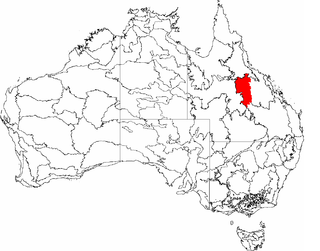
The Barcaldine Region is a local government area in Central West Queensland, Australia. Established in 2008, it was preceded by three previous local government areas which had existed for over a century.

Lake Galilee is a semi-arid salt lake in the locality of Galilee, Barcadline Region, within the Desert Uplands area of Central West Queensland, Australia. The lake is about 36 kilometres long, up to 12.5 kilometres wide and covers approximately 25,700 hectares.

The Desert Uplands is an interim Australian bioregion located in north and central western Queensland which straddles the Great Dividing Range between Blackall and Pentland.

Cornish Creek is a former rural locality in the Barcaldine Region, Queensland, Australia. In the 2016 census, Cornish Creek had a population of 16 people.

Tablederry is a former rural locality in the Barcaldine Region, Queensland, Australia. In the 2016 census, Tablederry had a population of 32 people.

Bangall is a former rural locality in the Barcaldine Region, Queensland, Australia. In the 2016 census, Bangall had a population of 4 people.

Upper Cornish Creek is a former rural locality in the Barcaldine Region, Queensland, Australia. In the 2016 census, Upper Cornish Creek had a population of 43 people.

Upland is a former rural locality in the Barcaldine Region, Queensland, Australia. In the 2016 census, Upland had a population of 12 people.

Ingberry is a former rural locality in the Barcaldine Region, Queensland, Australia. In the 2016 census, Ingberry had a population of 11 people.

Ibis is a former rural locality in the Barcaldine Region, Queensland, Australia. In the 2016 census, Ibis had a population of 4 people.

Pelican Creek is a former rural locality in the Barcaldine Region, Queensland, Australia. In the 2016 census, Pelican Creek had a population of 20 people.

Sardine is a former rural locality in the Barcaldine Region, Queensland, Australia. In the 2016 census, Sardine had a population of 5 people.

Barcaldine Downs is a former rural locality in the Barcaldine Region, Queensland, Australia. In the 2016 census, Barcaldine Downs had a population of 14 people.

Moombria is a former rural locality in the Barcaldine Region, Queensland, Australia. In the 2016 census, Moombria had a population of 0 people.

Narbethong was a rural locality in the Barcaldine Region, Queensland, Australia. In the 2016 census, Narbethong had a population of 0 people.

Patrick is a former rural locality in the Barcaldine Region, Queensland, Australia. In the 2016 census, Patrick had a population of 26 people.

Tara Station is a former rural locality in the Barcaldine Region, Queensland, Australia. In the 2016 census, Tara Station had a population of 10 people.

Dunrobin is a former rural locality in the Barcaldine Region, Queensland, Australia. In the 2016 census, Dunrobin had a population of 14 people.

Garfield is a former rural locality in the Barcaldine Region, Queensland, Australia. In the 2016 census, Garfield had a population of 37 people.

Mexico is a former rural locality in the Barcaldine Region, Queensland, Australia. In the 2016 census, Mexico had a population of 26 people.






